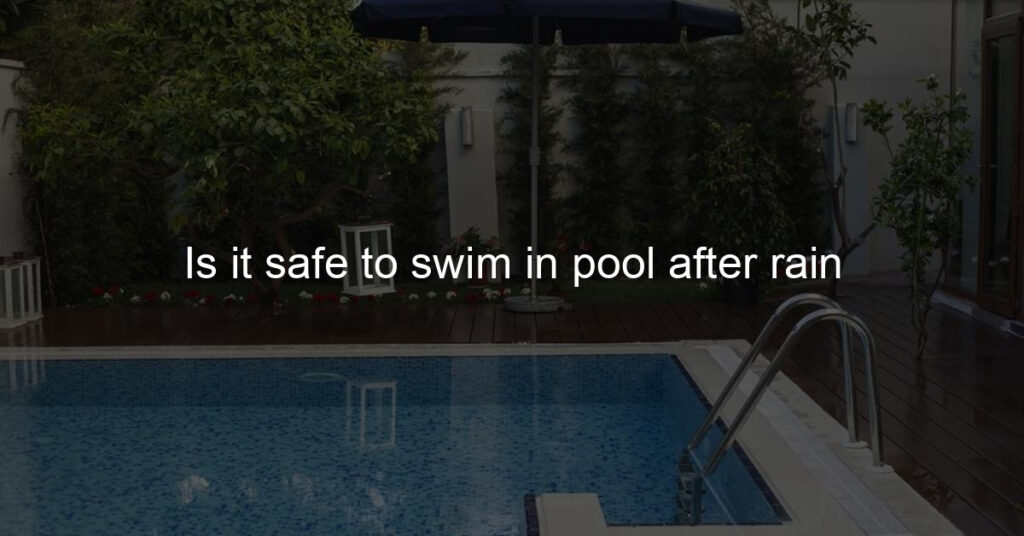Introduction: Is it Safe to Swim in a Pool After Rain?
Swimming is a popular recreational activity for many, especially during the hot summer months. However, the question often arises – is it safe to swim in a pool after it rains? This article aims to provide a comprehensive answer to this question, focusing on the effects of rain on pool water and the safety measures to consider.
- Overview of the topic: Rain can significantly impact your swimming pool’s water quality. It can introduce pollutants, alter the chemical balance, and even affect the pool’s overall safety. Understanding these effects is crucial to ensure a safe and enjoyable swimming experience.
- Importance of pool safety: Ensuring pool safety is paramount, not only for maintaining the health and well-being of swimmers but also for preventing accidents. This includes maintaining the right chemical balance, keeping the pool clean, and understanding the risks of swimming during or after rain.
Throughout this article, we will delve deeper into these topics, providing you with the necessary knowledge to make informed decisions about swimming in your pool after rain. Remember, safety should always be your top priority when it comes to enjoying your home swimming pool after heavy rains.
Understanding the Effects of Rain on Pool Water

When it comes to maintaining a healthy and clean home swimming pool, understanding the effects of rainwater on pool water is crucial. Rainwater can significantly influence your pool’s chemistry and cleanliness. Let’s delve into the basics of rain and pool safety.
Rain and Pool Safety: The Basics
Rainwater, though it may seem harmless, can significantly impact your pool’s overall health. Here are two key areas to consider:
- How rainwater can affect pool chemistry
- Rainwater is naturally acidic. Mixing with your pool water can decrease the pH level, making the water more acidic. This imbalance can lead to corrosion of pool equipment and irritation of skin and eyes, and can also affect the efficiency of your pool chemicals. Regular testing and adjustment of your pool’s pH level is essential after rainfall.
- Impact of rain on pool cleanliness
- When it rains, dirt, leaves, and other debris can easily find their way into your pool, making it dirty. Additionally, rainwater can carry small particles, algae spores, and other pollutants that can cloud your pool water and clog your filtration system. After a heavy downpour, it’s recommended to thoroughly clean and shock your pool to restore its cleanliness and clarity.
Understanding these effects of rain on your pool water is the first step towards maintaining a safe and clean swimming environment. Stay tuned for more insights on how to manage your pool post-rainfall.
Case Study: Swimming Pool After Rain
Let’s delve into a real-life example to understand the impact of a rain shower on a home swimming pool. This case study will provide a clear picture of the pool condition post-rainfall and the key takeaways for pool owners.
- Real-life example of pool condition post-rainfall
- Consider the case of Mr. Smith, a homeowner with a medium-sized outdoor swimming pool. After a heavy rainfall, he noticed that the clear blue water of his pool had turned cloudy. Upon testing, he found that the pH level of the water had risen from 7.4 to 8.2, indicating that the rainwater had significantly altered the pool’s chemistry. Additionally, debris such as leaves and dirt had been washed into the pool, affecting its cleanliness.
- Key takeaways from the case study
- From Mr. Smith’s experience, we can draw several important conclusions:
- Rainwater can significantly alter the pH level of pool water, making it less safe for swimming.
- Heavy rainfall can introduce debris into the pool, affecting its cleanliness and potentially leading to clogs in the filtration system.
- Post-rainfall, testing the pool water and adjusting the chemical balance as needed is essential. It may also be necessary to clean the pool and check the filtration system for any blockages.
In conclusion, while light rain may not significantly affect a swimming pool, heavy rainfall can lead to changes in pool water chemistry and cleanliness that must be addressed. As a pool owner, it’s important to be aware of these potential issues and take steps to maintain your pool after rain.
Can You Swim in Light Rain?
Many pool owners often wonder if swimming in their home swimming pool is safe during light rain. While it may seem like a harmless and even fun activity, there are certain risks and precautions that should be considered. Let’s explore these in detail.
- Understanding the risks associated with swimming in light rain
- Swimming in light rain can pose several risks. The most immediate concern is the potential for the pool’s chemical balance to be disrupted. Rainwater is naturally acidic, and when it mixes with your pool water, it can alter the pH levels, making the water less safe for swimming. Additionally, rain can bring with it airborne contaminants, including dust, pollen, and pollutants, which can affect the water quality.Another risk is reduced visibility. Raindrops falling on the pool surface can create a visual disturbance, making it harder to see other swimmers, objects, or the pool’s edges. This can increase the chances of accidents or collisions.
- Precautions to take when swimming in light rain
- Despite these risks, if you still wish to swim during light rain, there are certain precautions you can take. Firstly, constantly monitor the weather. If the rain intensifies or if there’s any sign of thunder or lightning, exit the pool immediately. Lightning can strike water, and swimming pools are no exception.Secondly, regularly test your pool’s water quality, especially after rain, to ensure it’s safe for swimming. This includes checking the pH levels, chlorine levels, and overall cleanliness. If the water quality is compromised, refrain from swimming until it’s been properly treated.
Lastly, be extra cautious while swimming. With reduced visibility, it’s important to swim slowly, avoid diving, and stay aware of your surroundings to prevent accidents.
In conclusion, while swimming in light rain is possible, it’s important to understand the associated risks and take necessary precautions. Always prioritize safety when enjoying your home’s swimming pool or outdoor pool.
Swimming While Raining Lightning: A Dangerous Combination
Swimming is a fun and healthy activity that many people enjoy. However, it’s crucial to understand when it’s safe to swim and when it’s not. One of the most dangerous times to swim is during a thunderstorm, especially when there’s lightning. Let’s explore why this is so dangerous and why you should avoid it.
- Explaining the dangers of swimming during a thunderstorm
Thunderstorms can be unpredictable and dangerous, especially when you’re in the water. The primary concern is the risk of being struck by lightning. According to Wikipedia, water conducts electricity, and lightning’s current can travel through the water. This means that if lightning strikes the water where you’re swimming, you could be electrocuted. Even if the lightning strikes far away, the electrical discharge can still reach you.
Besides the risk of lightning, thunderstorms can also bring heavy rain and strong winds. These conditions can make the water choppy and difficult to swim in, increasing the risk of drowning, especially for less experienced swimmers.
- Why you should avoid swimming when there’s lightning
As mentioned earlier, water conducts electricity. This means that if lightning strikes your pool, the electrical current can travel through the water and potentially electrocute anyone in the pool. This is why it’s crucial to avoid swimming during a thunderstorm.
According to the National Weather Service, you should wait at least 30 minutes after the last clap of thunder before going back into the water. This is because lightning can still strike even after the rain or storm has stopped.
In conclusion, while swimming is a great way to relax and stay fit, it’s important to prioritize safety. Always keep an eye on the weather and avoid swimming during a thunderstorm, especially when there’s lightning.
Should You Go to the Beach After it Rains?
After a refreshing rainfall, you might be tempted to head to the beach for a swim. But, is it safe to swim in pool after rain? Let’s compare the safety of swimming in a pool versus the ocean after rain and understand the risks of swimming at the beach post-rainfall.
- Comparing the safety of swimming in a pool vs. the ocean after rain
- Swimming in a pool after rainfall is generally safer than swimming in the ocean. This is because pools are treated with chemicals like chlorine that kill bacteria and other harmful microorganisms. On the other hand, the ocean can become polluted after rain due to runoff from streets and sewers, which can contain harmful bacteria and pollutants. According to a Wikipedia article on stormwater, this runoff can contaminate coastal waters, making them unsafe for swimming.
- Understanding the risks of swimming at the beach post-rainfall
- Swimming at the beach after it rains can pose several risks. As mentioned earlier, the water quality can be poor due to the runoff from the streets and sewers. This can lead to illnesses like stomach upset, skin rashes, and ear and eye infections. Additionally, the rain can stir up the ocean, making the currents stronger and the waves bigger, which can be dangerous for swimmers. It’s always a good idea to check the water quality reports and beach conditions before heading out for a swim after it rains.
In conclusion, while the allure of the pool pump the beach after a rainfall might be strong, it’s essential to consider the potential risks. Always prioritize your safety and health when deciding whether to swim in a pool or the ocean after it rains.
Can You Open a Pool in the Rain?
As a pool owner, you might wonder if it’s possible to open your pool when it’s raining. The answer is yes, but there are several factors to consider and steps to take to ensure the process is done correctly and safely.
- Factors to Consider When Deciding to Open a Pool in the Rain
- Before deciding to open your pool during a rainstorm, consider the following factors:
- Rain Intensity: Light rain may not significantly affect your pool’s water balance. However, heavy rain can dilute the chemicals and alter the pH level, making the water unsafe for swimming.
- Water Level: Rain can cause the water level in your pool to rise. If the water level gets too high, it can lead to overflow and potential damage to your pool and surrounding areas.
- Debris: Rain often brings wind, blowing leaves, dirt, and other debris into your pool. This can lead to clogged filters and pumps.
- Steps to Take When Opening a Pool in the Rain
- If you decide to open your pool during the rain, follow these steps:
- Monitor the Weather: Keep an eye on the weather forecast. Waiting until the weather clears might be best if heavy rain is predicted.
- Check the Water Level: If the water level is too high, drain some water to prevent overflow.
- Clean the Pool: Remove any debris from the pool to prevent clogging.
- Test the Water: After the rain stops, test the water’s pH and chemical levels. If necessary, add chemicals to rebalance the water.
Remember, safety should always be your top priority. Consult a pool professional if you’re unsure about opening your pool in the rain.
Pool Safety After Rain: A Comprehensive Guide
Ensuring the safety of your home swimming pool after rainfall is crucial. Rain can significantly alter the chemical balance of your pool water, making it unsafe for swimming. This guide will help you understand how to check your pool’s water chemistry even after rain and maintain a healthy and safe swimming environment.
Checking Pool Chemistry After Rain
After a rainfall, it’s essential to check your pool’s chemistry. Rainwater can introduce contaminants and dilute the chemicals in your pool, disrupting the balance and excess water. Here’s how you can do it:
- How to test pool water
- Testing your pool water after rain is a simple process. You’ll need a pool testing kit, which you can purchase from any pool supply store. Fill the vials in the kit with pool water, then add the provided reagents. Compare the color of the water in the vials to the color chart in the kit to determine your pool’s chlorine, pH, and alkalinity levels.
- Understanding pool water balance
- Pool water balance refers to the levels of different chemicals in your pool water. The key factors you must consider are pH, alkalinity, and chlorine levels. The ideal pH level for pool water is between 7.2 and 7.6. Alkalinity should be between 80 and 120 parts per million (ppm), and chlorine levels should be between 1 and 3 ppm. Regular testing and adjusting of these levels will ensure your pool water remains safe and clear.
Remember, safety should always be your top priority for your home swimming pool. Regularly checking and adjusting your pool’s chemistry after rain will help maintain a safe and enjoyable swimming environment for everyone.
Cleaning and Maintaining Your Pool Post-Rainfall
After a rainfall, cleaning and maintaining your own pool’s surface is crucial to ensure it’s safe for use. Here’s how you can do it:
- Steps to clean your pool after rain
- Following a rainstorm, your pool may have collected debris and its chemical balance might be off. Here are the steps to clean your pool:
- Remove any visible debris using a pool net.
- Check the pool’s pH levels using a pool testing kit. The ideal pH level is between 7.2 and 7.6.
- If the pH level is too high, add a pH reducer. If it’s too low, add a pH increaser.
- Check the pool’s chlorine levels. The ideal level is between 1.0 and 3.0 ppm.
- If the chlorine level is too low, add more chlorine. If it’s too high, let the pool sit without adding any chemicals until it decreases.
- Run the pool filter for at least 8 hours to circulate the chemicals and clean the water.
- Maintenance tips for keeping your pool safe post-rainfall
- Regular maintenance is key to keeping your pool safe and clean after rainfall. Here are some tips:
- Always keep a pool cover on when not used to prevent debris from entering the pool.
- Regularly check and adjust the pool’s chemical levels to maintain a safe and clean swimming environment.
- Keep the pool’s filter clean and in good working condition. Replace it as needed.
- Consider hiring a professional pool service for regular maintenance and cleaning.
Remember, a clean and well-maintained pool is not only more enjoyable to swim in, but it’s also safer for you and your family. Regular cleaning and maintenance after rainfall can help ensure your pool stays in top condition all year round.
Conclusion: Swimming in Rain and Rain Effect on Swimming Pool
As we wrap up our discussion on the impacts of rain on swimming pools and the safety of swimming during or after a large amount of rainfall, it’s crucial to revisit the key points we’ve covered. This will help you make informed decisions and maintain your pool in the best possible condition.
- Recap of key points discussed:
- We’ve learned that rain can significantly alter the chemical balance of your pool water, necessitating regular testing and adjustment. Swimming in light rain is generally safe, but heavy rain or thunderstorms pose serious safety risks. Opening your pool in the rain is not recommended due to potential water contamination. Lastly, we’ve provided a comprehensive guide on pool safety after rain, highlighting the importance of proper pool maintenance and safety precautions.
- Final thoughts on swimming in a pool post-rainfall:
- Swimming in a pool post-rainfall can be safe, provided you’ve taken the necessary steps to ensure the water quality and safety. Regular testing and adjustment of your pool water, as well as thorough cleaning, are essential. Always remember, safety should always be your top priority when it comes to swimming. Whether it’s rain or shine, maintaining a clean and safe pool environment is key to enjoying your swimming experience.
In conclusion, while rain can significantly affect your pool, these can be managed with proper care and maintenance. Remember, it’s not just about keeping the surface of your pool clean, but also ensuring it’s safe for everyone to enjoy. Happy swimming!














